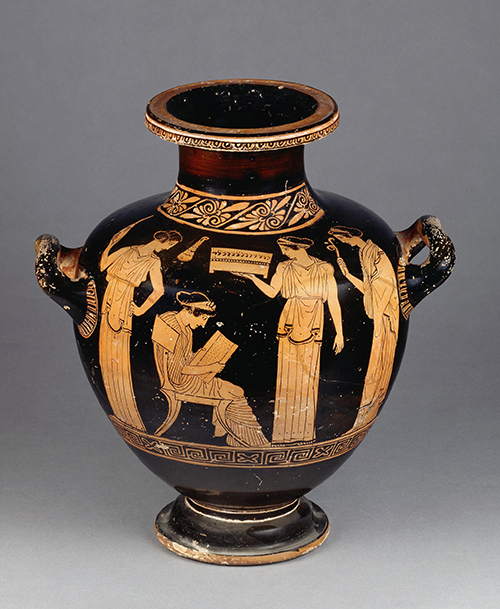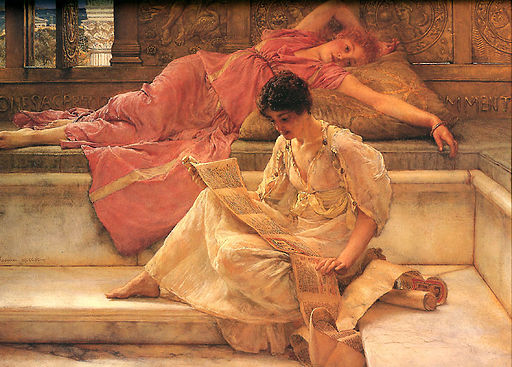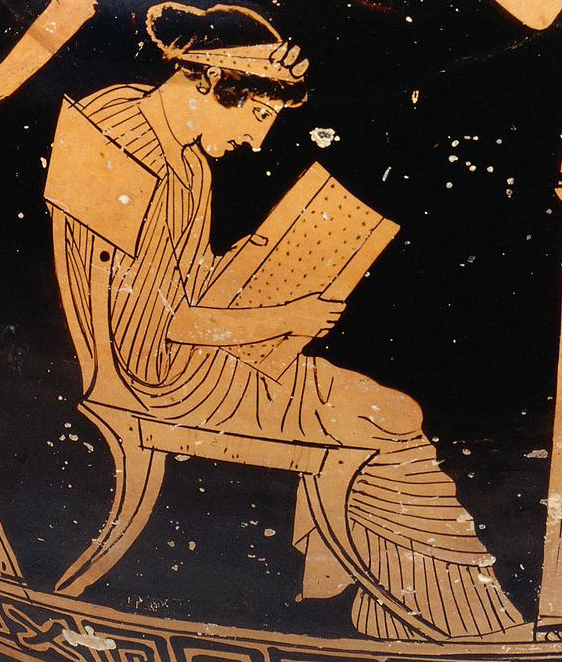2021.09.07 | By Gregory Nagy
§0. In the classical Athenian vase painting that I have chosen as the lead-off illustration for my essay here, the painter has pictured a woman, seated, reading out loud. Her mouth is part-open, and her lips are moving, it seems. She is reading from a scroll of papyrus—sometimes called a roll—and the painter has fancifully indicated, with stylized dots, the lines of the song that she is reading, sixteen lines in all. Whenever I look at this picture, I think of a basic metrical unit, the so-called “Sapphic strophe,” traditionally formatted as a stanza consisting of four lines, which was the metrical building-block of songs attributed to Sappho in what had been Scroll 1 of Sappho’s songs as edited by researchers at the Library of Alexandria. I think further to myself: maybe the sixteen lines in the picture represent four Sapphic strophes? I think even further: maybe the woman is reading the text of a song of Sappho? Following up on these thoughts, I tried a thought experiment: I would read out loud the bare text, as transmitted by way of the Alexandrian textual tradition, of the seven Sapphic strophes of Song 1 in Scroll 1 of Sappho, and I would make an audio recording that I would try out on members of a Comparative Literature seminar that I have organized, where our group engages in comparative studies of “lyric” writ large. But then I had a new idea: why not share more generally my hit-or-miss effort? So, I make public here, further below, under the lead-off illustration, an initial audio record of my experimental reading. My experiment, as experts in Greek literature will recognize right away, was hardly successful as a performance, since I found myself running out of breath time and again as I kept attempting to follow the metrical rules underlying the rhythmical structure of Song 1. But I succeeded at least in developing a deeper appreciation, as I will explain in the paragraphs that follow, of the exquisite verbal artistry that must have gone into the composition of Sappho’s Song 1.

§1. Having now shown the picture of the woman reading from the scroll or roll of papyrus, I now share my makeshift audio recording of Sappho’s Song 1. And I should note, already in advance, that I plan to update, from time to time, the recording that I share here, attempting what I hope will be improved re-recordings at this place in my posting. Here, then, is the audio:
§2. As I announced in my recording, before I started to read the text, I am trying to pronounce the text of Sappho’s Song 1 with an Athenian “accent,” that is, pretending that I was some random Athenian trying to read the text. That said, I now show the Greek text itself, as transmitted from the Alexandrian textual tradition, followed by a working translation of mine:
|1 ποικιλόθρον’ ἀθανάτἈφρόδιτα, |2 παῖ Δίοc δολόπλοκε, λίϲϲομαί ϲε, |3 μή μ’ ἄϲαιϲι μηδ’ ὀνίαιϲι δάμνα, |4 πότνια, θῦμον, ||5 ἀλλὰ τυίδ’ ἔλθ’, αἴ ποτα κἀτέρωτα |6 τὰc ἔμαc αὔδαc ἀίοιϲα πήλοι |7 ἔκλυεc, πάτροc δὲ δόμον λίποιϲα |8 χρύϲιον ἦλθεc ||9 ἄρμ’ ὐπαϲδεύξαιϲα· κάλοι δέ ϲ’ ἆγον |10 ὤκεεc ϲτροῦθοι περὶ γᾶc μελαίναc |11 πύκνα δίννεντεc πτέρ’ ἀπ’ ὠράνωἴθε|12 ροc διὰ μέϲϲω· ||13 αἶψα δ’ ἐξίκοντο· ϲὺ δ’, ὦ μάκαιρα, |14 μειδιαίϲαιϲ’ ἀθανάτωι προϲώπωι, |15 ἤρε’ ὄττι δηὖτε πέπονθα κὤττι |16 δηὖτε κάλημμι ||17 κὤττι μοι μάλιϲτα θέλω γένεϲθαι |18 μαινόλαι θύμωι· τίνα δηὖτε πείθω |19 βαῖϲ᾿ ἄγην ἐc ϲὰν φιλότατα; τίc ϲ’, ὦ |20 Ψάπφ’, ἀδικήει; ||21 καὶ γὰρ αἰ φεύγει, ταχέωc διώξει, |22 αἰ δὲ δῶρα μὴ δέκετ’, ἀλλὰ δώϲει, |23 αἰ δὲ μὴ φίλει, ταχέωc φιλήϲει |24 κωὐκ ἐθέλοιϲα. ||25 ἔλθε μοι καὶ νῦν, χαλέπαν δὲ λῦϲον |26 ἐκ μερίμναν, ὄϲϲα δέ μοι τέλεϲϲαι |27 θῦμοc ἰμέρρει, τέλεϲον, ϲὺ δ’ αὔτα |28 ϲύμμαχοc ἔϲϲο.
stanza 1||1 You with pattern-woven flowers, immortal Aphrodite, |2 child of Zeus, weaver of wiles, I implore you, |3 do not dominate with hurts and pains, |4 Mistress, my heart! stanza 2||5 But come here [tuide], if ever at any other time |6 hearing my voice from afar, |7 you heeded me, and leaving the palace of your father, |8 golden, you came, stanza 3||9 having harnessed the chariot; and you were carried along by beautiful |10 swift sparrows over the dark earth |11 swirling with their dense plumage from the sky through the |12 midst of the aether, stanza 4||13 and straightaway they arrived. But you, O holy one, |14 smiling with your immortal looks, |15 kept asking what is it once again this time [dēute] that has happened to me and for what reason |16 once again this time [dēute] do I invoke you, stanza 5||17 and what is it that I want more than anything to happen |18 to my frenzied [mainolās] heart [thūmos]? “Whom am I once again this time [dēute] to persuade, |19 setting out to bring [agein] her to your love? Who is doing you, |20 Sappho, wrong? stanza 6||21 For if she is fleeing now, soon she will be pursuing. |22 If she is not taking gifts, soon she will be giving them. |23 If she does not love, soon she will love |24 even against her will.” stanza 7||25 Come to me even now, and free me from harsh |26 anxieties, and however many things |27 my heart [thūmos] yearns to get done, you do for me. You |28 become my ally in war.
Song 1 of Sappho = Prayer to Aphrodite
§3. In the Greek text here, I show in red highlights the various places where I found that I needed to pause, inside the metrical sequence of the rhythm, just to catch my breath. If I did not stop, I found that my lungs were starting to give out by the time that I was reaching the closure of a fixed syntactical sequence. Also, I have highlighted in green the one place where I found that I would be spoiling the sound-effects of the wording if I did pause, even though the metrics of the rhythm would have allowed me to do exactly that, to pause.
§4. The places highlighted in red caught me by surprise, since I have been used to advising readers of Greek poetry that they should not take pauses except, optionally, at the ends of metrical units, that is, at verse-end or, to say it more inclusively, at colon-end. In the case of the four-line Sapphic strophe, my advice would have meant that you could optionally take a pause only at the end of line 1, at the end of line 2, and then not at the end of line 3 but again at the end of line 4. And yet, to my surprise, I found that such a metrical reading would make my lungs give out—unless I paused at the places highlighted in red—but these places were endings of syntactical units, not of metrical units. In other words, I found that I had to obey some syntactical pauses and ignore some would-be metrical pauses. And this in turn meant that my recitation needed to follow the flow of the syntax, so that the operative metrical sequences became submerged as a sort of hidden undercurrent.
§5. The problem with such reading aloud, in any case, is that the very act of pronouncing the words in concert with the metrical system that contains them, that is, in concert with the underlying rhythmical structure, is an incomplete procedure. What is missing here is an essential feature of the song as composed for performance, and that feature is the melody that operates in concert with the rhythm and with the syntax. And the sad fact is, the melodies of Sappho’s songs have not survived in the textual tradition. A true Sapphic performance would have required an interaction of the syntax with both the rhythm and the melody, whereas all we have left is an interaction of the syntax with the rhythm but without the melody. True, at least the rhythm can be recovered for the most part—simply by reading, as accurately as possible, the phonological realia preserved in the alphabetic writing of the words. By contrast, the melody has been lost.
§6. There is one consolation for this loss. Visual representations that clearly point to such melodic performance have survived. And this kind of performance can even be identified with the singing of songs identified as originating from Sappho. To start with an explicit identification with Sappho, I cite a vase painting (Athens, National Archaeological Museum inventory number 1260, linked to the Beazley Archive here) that is closely parallel to what we have seen in the painting I chose for the cover illustration. In this case, the painter pictures a seated woman reading from a papyrus roll some choice words of song that are indicated with lettering written into the uncovered “page” of the roll as also into the borders of the roll that frame the page (for a detailed description, I cite Yatromanolakis 2007:143–160), and the further lettering that hovers over the scene reads ΣΑΠΠΩΣ, which I interpret as a rendering of the genitive case of Sappho’s name, Sapphoûs—an indication, I think, that the words of the song that is read here are imagined as originating from Sappho herself. In another vase painting that features a parallel scene (pictured by the so-called Niobid Painter: New York, Solow Art and Architecture Foundation, linked to the Beazley Archive here), a woman who is shown reading from a roll of papyrus that a female companion holds up for her to view is actually accompanying herself on a lyre while reading—that is, while notionally singing. And the chair on which she is seated is positioned on an ‘elevation’, a bêma—which indicates performance at a public concert. Such an imagined performance, in “real life,” would I think have taken place at the seasonally recurring Athenian festival of the Panathenaia, where the real performers would have been male professionals known as kitharōidoi ‘citharodes’ or ‘lyre-singers’, who would be “channeling” Sappho, as it were, in competitive performances of classical lyric song (Nagy 2018.12.06, linked here, §§7–12).
§7. I close by showing further pictures that show women reading poetry and thereby notionally singing songs in imaginary worlds of idealized lyric performance:



Bibliography
Nagy, G. 2013. The Ancient Greek Hero in 24 Hours. Cambridge, MA. http://nrs.harvard.edu/urn-3:hul.ebook:CHS_NagyG.The_Ancient_Greek_Hero_in_24_Hours.2013.
Nagy, G. 2015.11.05. “Once again this time in Song 1 of Sappho.” Classical Inquiries. https://classical-inquiries.chs.harvard.edu/once-again-this-time-in-song-1-of-sappho/.
Nagy, G. 2018.12.06. “Previewing an essay on the shaping of the Lyric Canon in Athens.” Classical Inquiries. https://classical-inquiries.chs.harvard.edu/previewing-an-essay-on-the-shaping-of-the-lyric-canon-in-athens/.
Nagy, G. 2019. “On the Shaping of the Lyric Canon in Athens.” In The Reception of Greek Lyric Poetry in the Ancient World: Transmission, Canonization and Paratext, ed. B. Currie and I. Rutherford, 95–111. Vol. 5 of Studies in Archaic and Classical Greek Song. Mnemosyne Supplements 430. Leiden and Boston. https://doi.org/10.1163/9789004414525_005.
Yatromanolakis, D. 2007. Sappho in the Making: An Anthropology of Reception. Hellenic Studies 28. Cambridge, MA, and Washington, DC.

